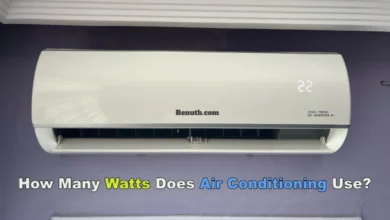How Many Watts Does a Refrigerator Use?

Refrigerators are a staple in every household, but have you ever wondered how much energy they actually consume? Understanding how many watts does a refrigerator use is essential for managing your electricity bills, improving energy efficiency, and even planning alternative power solutions like solar energy. Whether you’re looking to reduce costs or simply be more energy-conscious, knowing the power consumption of your refrigerator can make a big difference. In this guide, we’ll break down everything you need to know about refrigerator watt consumption, from typical usage to ways you can optimize efficiency.
Contents
- 1 How Much Electricity Does a Refrigerator Use?
- 2 How Many Watts Do Refrigerators Use? Breakdown By Time Period
- 3 How Many Volts and Amps Does a Refrigerator Use?
- 4 How Can You Lower Your Refrigerator’s Energy Consumption?
- 5 How Much Electricity Does a Mini Fridge Use?
- 6 How Much Does It Cost to Power a Refrigerator?
- 7 Monthly and Yearly Costs to Run a Refrigerator by State
- 8 Calculate How Much Energy Your Own Refrigerator Uses
- 9 How Many Solar Panels Does It Take to Run a Refrigerator?
- 10 How Much Energy Do Other Appliances Use in the Home?
- 11 How Much Electricity Does a Home Use?
- 12 Real-Life Examples and Success Stories
How Much Electricity Does a Refrigerator Use?
The energy usage of refrigerators depends on their size, type, energy efficiency rating, and usage habits. On average, standard refrigerators consume between 300 to 800 watts. Older models may use even more power, especially if they are not ENERGY STAR certified.
Most modern refrigerators are designed to be energy-efficient, using approximately 150 to 400 kWh per year. This translates to around 1 to 2 kWh per day, which is considered moderate refrigerator energy consumption for most households.
Understanding how many watts does a refrigerator use helps homeowners make better decisions about their energy usage and improve efficiency.
How Many Watts Do Refrigerators Use? Breakdown By Time Period
The power consumption of refrigerators varies based on their usage pattern. Below is a breakdown of power usage by different time periods:
Refrigerator Watt Consumption (mini vs standard)
| Time Period | Average Watts Used (Standard Fridge) | Average Watts Used (Mini Fridge) |
|---|---|---|
| Hourly | 150 to 400 watts | 50 to 100 watts |
| Daily | 1 to 2 kWh | 0.5 to 1 kWh |
| Monthly | 30 to 60 kWh | 15 to 30 kWh |
| Yearly | 150 to 400 kWh | 80 to 150 kWh |
How Many Volts and Amps Does a Refrigerator Use?
Refrigerators typically operate on 120 volts in the United States. The amperage varies based on the size and type of the refrigerator but usually ranges between 3 to 6 amps for standard models and 1 to 2 amps for mini fridges.
Formula to calculate wattage:
Watts = Volts × Amps
For example, if a refrigerator uses 120 volts and 5 amps, the power consumption would be:
120 × 5 = 600 watts
How Can You Lower Your Refrigerator’s Energy Consumption?
Reducing your fridge power consumption can be achieved with a few practical steps.
- Set the Correct Temperature: Keeping your refrigerator at the ideal temperature of 35°F to 38°F (1.7°C to 3.3°C) and your freezer at 0°F (-18°C) helps maintain energy efficiency.
- Ensure Proper Ventilation: Make sure there’s enough space around the refrigerator for air circulation, especially near the coils, to prevent overheating and increased energy use.
- Keep the Door Closed: Avoid leaving the refrigerator door open for extended periods. Each time it opens, warm air enters, causing the appliance to work harder.
- Regularly Clean the Coils: Dust and debris accumulation on the coils can reduce efficiency. Cleaning them every 6 months can improve performance.
- Check the Seals: Worn or damaged seals can cause cold air to leak. Replacing faulty seals can significantly improve energy efficiency.
- Minimize Heat Exposure: Keep your refrigerator away from heat sources such as ovens, dishwashers, or direct sunlight to reduce energy consumption.
- Organize the Interior: Keeping items well-organized ensures that air circulates properly, helping the refrigerator maintain a consistent temperature.
- Upgrade to an Energy-Efficient Model: Older models tend to use more energy. Switching to an ENERGY STAR-certified refrigerator can lower your overall energy consumption.
Implementing these steps can significantly reduce your refrigerator watt consumption and lower your energy bills over time.
How Much Electricity Does a Mini Fridge Use?

Mini fridges are generally more energy-efficient than standard refrigerators, but they still contribute to overall refrigerator energy consumption. Most mini fridges use between 50 to 100 watts when running. This translates to approximately 0.5 to 1 kWh per day or around 15 to 30 kWh per month.
How Much Does It Cost to Power a Refrigerator?
The cost of running a refrigerator varies based on its refrigerator watt consumption, electricity rates, and usage. On average, powering a standard refrigerator costs between $5 to $15 per month. Mini fridges are more affordable, typically costing between $2 to $5 per month.
Monthly and Yearly Costs to Run a Refrigerator by State
Electricity rates vary across the United States, which directly affects the refrigerator power consumption cost. Below is a table showcasing the estimated monthly and yearly costs for a standard refrigerator by state.
| State | Average Electricity Rate (cents per kWh) | Monthly Cost (Standard Fridge) | Yearly Cost (Standard Fridge) |
|---|---|---|---|
| California | 23.22 | $13.93 | $167.16 |
| Texas | 12.01 | $7.20 | $86.40 |
| New York | 20.70 | $12.42 | $149.04 |
| Florida | 11.69 | $7.01 | $84.12 |
| Illinois | 13.14 | $7.89 | $94.68 |
| Washington | 10.38 | $6.23 | $74.76 |
| Average (US) | 13.31 | $8.00 | $96.00 |
Calculate How Much Energy Your Own Refrigerator Uses
To calculate how much refrigerator energy consumption affects your bill, you need to know the wattage, usage hours, and your local electricity rate. Use the formula below:
Daily Usage (kWh) = (Wattage × Hours Used per Day) / 1,000
Monthly Usage (kWh) = Daily Usage × 30
Cost = Monthly Usage × Local Electricity Rate (cents per kWh)
For example, if your refrigerator uses 400 watts and runs for 8 hours per day:
Daily Usage = (400 × 8) / 1,000 = 3.2 kWh
Monthly Usage = 3.2 × 30 = 96 kWh
If your electricity rate is 13 cents per kWh, the monthly cost would be:
Cost = 96 × 0.13 = $12.48
How Many Solar Panels Does It Take to Run a Refrigerator?
The number of solar panels needed to power a refrigerator depends on the refrigerator watt consumption, sunlight hours, and the efficiency of the solar panels. Typically, a standard refrigerator using 400 watts would require around 2 to 3 solar panels rated at 300 watts each if you have 5 to 6 hours of sunlight per day.
How Much Energy Do Other Appliances Use in the Home?
Different household appliances consume varying amounts of energy. Understanding their power usage can help you reduce energy costs and improve efficiency. Below is a table showing the average power consumption of common home appliances.
| Appliance | Average Watts (Running) | Estimated Monthly Usage (kWh) |
|---|---|---|
| Refrigerator | 300 – 800 watts | 30 – 60 kWh |
| Air Conditioner | 1,000 – 5,000 watts | 100 – 500 kWh |
| Washing Machine | 500 watts | 10 – 30 kWh |
| Dryer | 2,000 – 6,000 watts | 60 – 100 kWh |
| Oven | 2,000 – 5,000 watts | 50 – 80 kWh |
| Dishwasher | 1,200 – 1,500 watts | 30 – 50 kWh |
| Television | 100 – 400 watts | 15 – 30 kWh |
| Computer (Desktop) | 200 – 500 watts | 10 – 30 kWh |
| Microwave Oven | 800 – 1,200 watts | 10 – 20 kWh |
| Water Heater | 3,000 – 4,500 watts | 150 – 400 kWh |
Knowing the power consumption of various appliances helps you make better decisions about energy usage, especially when looking to reduce overall household consumption.
How Much Electricity Does a Home Use?
An average American household uses approximately 877 kWh per month or 10,500 kWh per year. Refrigerator energy consumption generally accounts for around 4% to 6% of total household energy consumption.
By understanding the refrigerator watt consumption of your appliance, you can make informed decisions to reduce energy costs and even explore alternative power sources like solar energy.
Real-Life Examples and Success Stories
Adding real-life examples and success stories can significantly enhance the credibility and relatability of your article. Particularly, case studies involving solar-powered refrigerators, energy-efficient refrigerators, or simply understanding how many watts a refrigerator uses can provide valuable insights for readers looking to improve efficiency and reduce energy costs.
1. Energy-Efficient Refrigerators (Case Studies)

Example 1: Saving Energy with ENERGY STAR Certified Refrigerators
- Scenario: In California, a homeowner replaced an old, inefficient refrigerator with a new ENERGY STAR certified model.
- Result: Annual energy consumption decreased by approximately 30%, leading to a monthly savings of around $12 on electricity bills.
Example 2: Improving Efficiency in Commercial Kitchens
- Scenario: A restaurant in New York City upgraded all its refrigerators to ENERGY STAR certified models to enhance energy efficiency.
- Result: Yearly energy consumption was reduced by 25%, resulting in annual savings of nearly $1,500 on energy costs.
2. Solar-Powered Refrigerators (Case Studies)

Example 3: Off-Grid Living with Solar-Powered Refrigerators
- Scenario: A family living on an off-grid farm in Texas opted for solar-powered refrigerators to achieve complete energy independence.
- Result: Using a 10 kW solar panel system, they met their daily energy needs, resulting in approximately $20 in monthly savings.
Example 4: Portable Solar-Powered Refrigerators for Camping
- Scenario: A group of campers in California used portable refrigerators powered by solar panels to keep their food and beverages cool during extended trips.
- Result: By utilizing a 200W solar panel and portable battery system, they successfully powered their fridge with an average daily consumption of 0.8 kWh.
3. Comparison: Standard Refrigerators vs. ENERGY STAR Refrigerators
| Feature | Standard Refrigerators | ENERGY STAR Refrigerators |
|---|---|---|
| Annual Energy Consumption | 500 kWh – 900 kWh | 300 kWh – 500 kWh |
| Cost Savings | None | 20% – 30% Reduction |
| Lifespan | Approximately 10 years | Approximately 12 years |
| Environmental Impact | High | Low |



